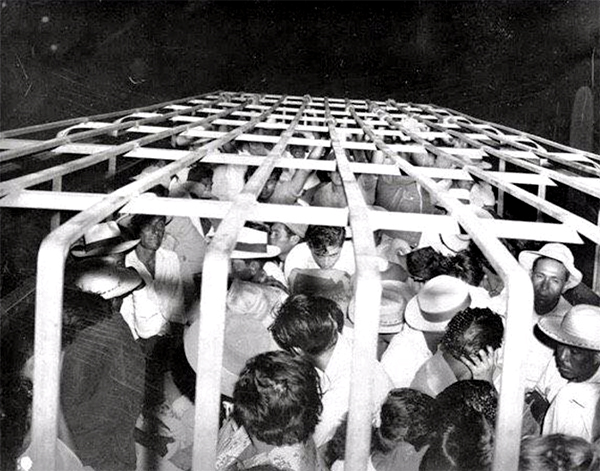

Donald Trump has promised to deport 1 million undocumented immigrants per year. It is difficult, but can be done. In 1954, as part of Operation Wetback, the Eisenhower administration deported 1.1 million Mexicans. This is what it looked like:

The logistics of this were enormous. But remember, President Eisenhower was the guy in charge of winning World War II. He was a brilliant strategist and was equally good at logistics. He knew how to organize vast numbers of people, vehicles, supply chains, and more into a well-oiled machine. Donald Trump may have no hair on the top of his head, and he may have spent an undue amount of time in close proximity to Nazis, but otherwise he is no Dwight Eisenhower.
The BBB appropriated $170 billion for border and immigration enforcement. Now Trump has 3½ years to make it actually work. The administration has to hire and train at least 10,000 new immigration workers in an economy where there are plenty of other (easier) jobs available. It needs to issue contracts to dozens, maybe hundreds, of companies to build detention facilities (and hope they don't rob the government blind and they actually do what the contract says and on time). The White House also has to expand the court systems and hire more immigration judges. The logistics of this are enormous and neither Trump nor Stephen Miller nor Border Czar Tom Homan has ever run anything on the scale that will be needed. And Elon Musk isn't around to herd the DOGEys looking for waste and abuse—and in a loosely monitored project this size, there will be a lot of it.
Homan understands this. On Friday he told Politico: "Look, this isn't easy. Ten thousand ICE officers? Never happened before." He didn't dare state how long it will be before the administration can get to 1 million removals/year. He also didn't mention what will happen when native-born American citizens get deported and the courts rule that is illegal. And what happens when one or more of them file and win big lawsuits against the government? Instead, Homan focused on buying better radios so agents can talk to each other in areas where there is no cellular phone service.
John Sandberg, the acting ICE director from 2013 to 2014, said that rapidly expanding ICE will not be easy. He highlighted the difficulty of recruiting, vetting, onboarding and training thousands of new workers and managers. It will require massively expanding ICE's HR department, building new training centers, leasing office space, and going through the process of writing tenders to acquire new vehicles, weapons and other equipment. And all this at a scale never before attempted. What could possibly go wrong? Sandberg said: "That is way harder than it sounds."
Now that most undocumented workers know that ICE is coming for them, they are going to be as careful as they can be (e.g., not going to church on Sundays), so just finding them will be problem #1. One (obvious) possibility is raiding businesses known to hire many undocumented workers, like meatpacking plants. The problem with that is that those businesses are often owned by large and powerful corporations that will squeal like stuck pigs when the government shuts them down. Trump may then have to tell ICE to skip the low-hanging fruit and find other ways to find potential deportees.
Past presidents, including Joe Biden, have gotten Congress to appropriate billions for some goal only to discover that "shovel-ready" projects are hard to come by. Just one example: Building a huge detention facility requires many permits and in some cases, requires using eminent domain to take over private property. The owners of the property are likely to sue, saying the government is not offering the fair market value for their property. Cases like that can take years to finish. Of course, the government can decide to build detention centers on federal land in the middle of the Sonoran desert in Arizona. That solves the eminent domain problem. But it creates the problem of building adequate roads to the construction site, and getting power, water, sewage facilities, and more infrastructure in place in the middle of the desert. That didn't happen automatically when Trump signed the bill on Friday. Then there is the small matter of hiring enough qualified, skilled construction workers who want to move to a burning desert for a job that will last maybe a year. Oh, and they will need housing, food, etc. Homan will soon discover how right Sandberg was. It won't be easy and there will be no easy wins for quite a while.
Separate from the issues of finding immigrants and building and staffing detention centers is the issue of the immigration courts. Judges in the immigration courts are not Art. III judges and don't need Senate confirmation. But they do need courtrooms, clerks, secretaries, computers and more. The current 700 immigration judges already have a backlog of 3.5 million cases. Adding another million cases per year is going to require many more judges. Maybe newly graduated law students might be willing to take the job for the experience, but suppose many of them take their work seriously, hold hearings, and decide many of the cases in favor of the immigrants? Then what? In short, getting the money was the easy part. Spending it in order to ramp up deportations to a million a year is the hard part. (V)